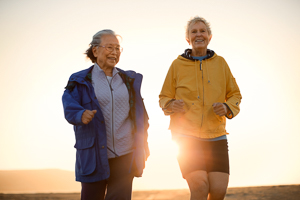Physical Activity as You Get Older
Topic Overview

It’s never too late to start getting active. Being fit is important for everyone. You can benefit from physical activity even if you think of yourself as “elderly” or you already have conditions such as arthritis or heart disease. Being more active will help you feel better and may even help you live longer.
If you haven’t been active for a long time, you may have no idea where to start. The important thing is to take that first step—and make that first step a small one.
Be smart about exercise
- Talk to your doctor before you start a fitness program, especially if you are older or worried about how exercise might affect your health. You may have health problems that limit what you can do.
- Don’t overdo it! If it hurts, stop. Some minor soreness or stiffness is to be expected at first, but pain is a warning sign to stop.
- If you have been inactive for years, start with about 5 to 10 minutes of activity at a time, and increase your time as you get more comfortable with the activity.
- Try to improve only a little bit at a time. Pick one area for improvement first. Set your personal goal in that area, and meet the goal before trying another area.
Being active can make life better
Many people become less active as they age, but staying active—or getting active, if you aren’t already—has definite benefits.
- Aerobic exercise strengthens your heart—which improves your health—and gives you more energy to do the things you like to do. It can also increase the amount of sleep you get at night and may reduce the time it takes for you to fall asleep. Water exercise may be a good choice for some older adults.
- Strengthening exercises can help you maintain your muscle, strengthen bones, and protect knees and other joints. These exercises include resistance training, such as lifting weights.
- Flexibility and stretching—which help provide a full range of motion for muscles and joints—can help you function at home, at work, and socially. Everyday tasks that are hard for you, such as tying shoelaces or reaching to a shelf, may become easier. When you stay flexible, you also keep a more natural walking pattern and decrease your chance of falling. Most flexibility that seems to be lost through aging is caused not by aging but by inactivity or lack of movement.
- Balance exercises help you have good posture. They can also be helpful to improve coordination and reduce your risk for falls. One type of balance exercise is to stand on one leg for 10 seconds. Stand on a flat surface and use a stable object (such as a heavy chair) for support. Yoga classes or DVDs can teach you poses that help improve your balance.
Being active can keep you healthy
Exercise also has these specific health benefits for older adults. It:footnote 1
- Improves blood pressure.
- Improves heart failure symptoms and shortens hospital stays.
- Improves cholesterol.
- Helps keep postmenopausal women from losing bone density.
- Helps joints work better, with less pain, in osteoarthritis.
- Improves sleep and reduces fatigue.
- Helps your brain work better and improves short-term memory.
- May lower the risk of some cancers.
- Lowers the risk of:
- Hip and spinal fractures.
- Falling.
- Coronary artery disease.
- Diabetes.
- Depression.
- Obesity.
Physical activity doesn’t have to be strenuous. Older adults can gain great health benefits with a moderate amount of physical activity. This can be done in longer sessions of moderately intense activities (such as walking) or in shorter sessions of more vigorous activities (such as fast walking or stair-walking).
Warning signs for older adults
When you exercise, it’s normal to have some minor muscle and joint soreness. But other signs may point to something more serious. Stop exercising if you think you might be having a heart attack. Call 911 right away. Symptoms include pain, pressure, or a strange feeling in your chest, back, neck, jaw, or upper belly, or in one or both shoulders or arms.
Current as of: May 5, 2019
Author: Healthwise Staff
Medical Review:E. Gregory Thompson MD – Internal Medicine & Adam Husney MD – Family Medicine & Kathleen Romito MD – Family Medicine & Elizabeth T. Russo MD – Internal Medicine
Topic Contents
This information does not replace the advice of a doctor. Healthwise, Incorporated, disclaims any warranty or liability for your use of this information. Your use of this information means that you agree to the Terms of Use. Learn how we develop our content.

